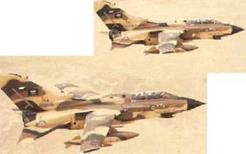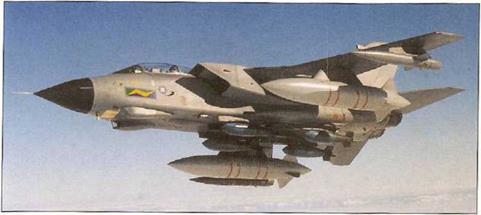Panavia Tornado IDS, ECR
|
![Panavia Tornado IDS, ECR Подпись: Specification: Panavia Tornado GR.Mk 1 Powerplant: two 71.50-kN (16.07b lb) Turbo- Union RB.199 Mk 103 turbofans Dimensions: wing span 13.91 m (45 it 7/ in] minimum sweep and 8.60 m (28 ft 2/ in) maximum sweep; length 16,72 rti (54 ft 104 in); height 5.95 m (19 ft 64 in) Weights: operating empty 14091 kg {31,065 lb): maximum take-off 27951 kg (61,620 lt>l Performance: limiting IAS 14B2 kmh [921 mph). service ceiling more than 15240 m (50,000 ft); combat radius 1390 km (863 miles) on a typical hMo-hi attack mission Armament: twe 27-mm IWKA-Mauser cannon with 180 rpg; maximum ordnance over 9000 kg (19,841 lb)](/img/1244/image227.gif) |
 |
|
T |
he Panavia Tornado, initially known as the Multi-Role Combat Aircraft iMRCA), was
designed to fulfil a tri-national requirement for a strike, interdiction, counter-air, close air support, reconnaissance, ana maritime attack aircraft. The prototype fiew on 14 August 1974, The Tornado IDS (interdictor/strike) variant was a compact variable geometry (swing-wing) aircraft, optimised for low level penetration by day or night, in all weathers. The aircraft was designed around sophisticated attack and terrain following radars.
Nine prototypes were followed by six pre – production aircraft, before production began. RAF orders totalled 228 production GR. IVIk 1s including 14 new GR. Mk 1A reconnaissance aircraft (and 14 GR. Mk 1A conversions). Some 26 were converted tc GR. IVIk 1В standards for *he maritime attack role with BAe Sea Eagle anti-ship missiles, and eighteen more were converted to carry the BAe ALARM anti-radar missile, with no change of designation.
A mid-life update planned for the early 1990s was cut-back to cover the provision of a new HUD, a FLIR. a digital moving map, a colour displays, and an updated weapon control system. A total of 142 aircraft are being converted to GR. Mk 4 and GR. IVIk 4A standard, although major problems were encountered with integrating new equipment and software. Upwards of 80 had been re delivered the squadrons before the aircraft was capable of even the most limited operational flying.
In Germany, the Luftwaffe received 212 aircraft and the Marineflieger received 112 while Italy received 100. The German and Italian reconnaissance requirements were initially met using a simple multi-sensor pod on standard IDS aircraft. The Luftwaffe and AMI did opt for a more sophisticated variant for defence suppression. The Tornado ECR (Electronic Combat and Reconnaissance) variant incorporates an advanced emitter location system, and has provision for two AGM-88 HARM mssiles under the fuselage. The last 35 German IDS aircraft were completed as ECRs, with an IR linescan mounted in a blister under the forward fuselage and with a FLIR immediately ahead, The linescan was subsequently removed and added to a new Tornado recce pod. Italy produced 16 ECRs (without FLIR or linescan) by converting existing aircraft.
A total of 96 IDS aircraft were delivered to the Royal Saudi Arabian Air Force under the Al Yamamah and Al-Yamamah II contracts, some with Sea Eagle and ALARM missiles, and some in GR. Mk 1A – IDS1R) – recce configuration.
Saudi Arabia was the only customer for the Tornado, outside the original partner nations of Britain, Germany and Italy.












